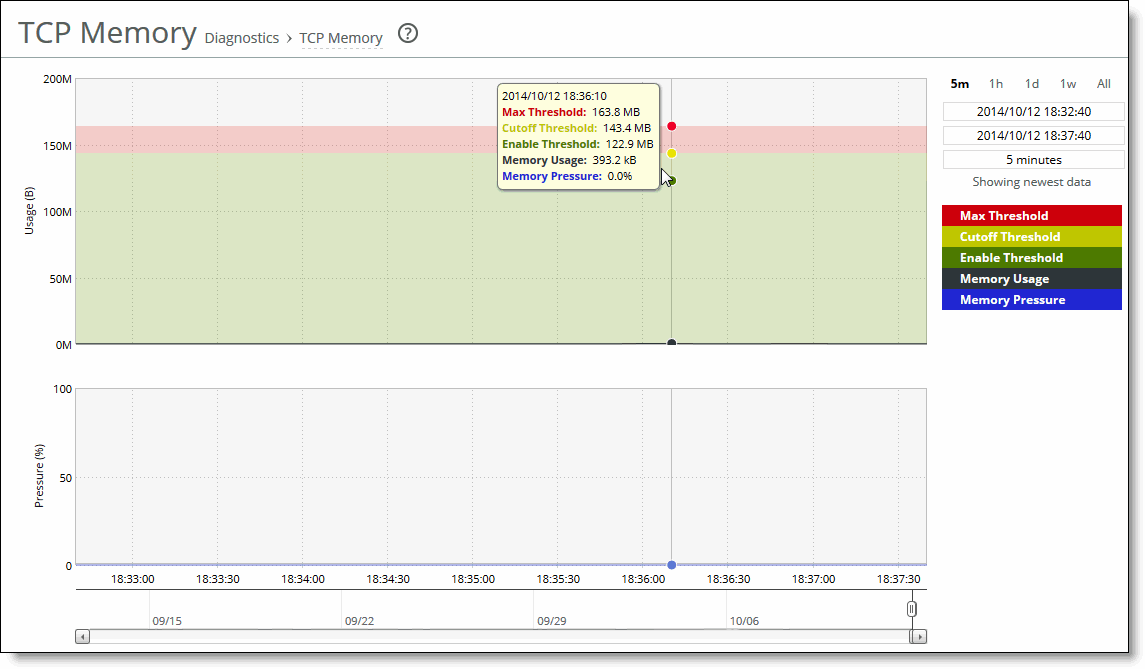Viewing TCP Memory Reports
The TCP Memory report simplifies the analysis of unexplainable throughput degradations, stalled and timed-out connections, and other network-related problems by providing the history of the TCP memory consumption and any TCP memory pressure events detected during network traffic processing. Use this report to gather preliminary information before calling Riverbed Support to troubleshoot an issue.
For details about the report format, see
Overview.
The TCP Memory report includes two graphs. The TCP usage graph provides the absolute number of memory bytes allocated by the TCP subsystem. This graph includes these statistics that describe TCP memory activity for the time period you specify.
Data Series | Description |
Max Threshold | Displays the maximum amount of memory bytes that the TCP stack can allocate for its needs. |
Cutoff Threshold | Displays the number of memory bytes allocated until the TCP memory allocation subsystem doesn’t apply memory-saving mechanisms and rules. As soon as the TCP memory consumption reaches the cutoff limit, the TCP stack enters a “memory pressure” state. This state applies several important limitations that restrict memory use by incoming and transmitted packets. In practice, this means that part of the incoming packets can be discarded, and user space code is limited in its abilities to send data. |
Enable Threshold | Displays the lower boundary of TCP memory consumption, when the memory pressure state is cleared and the TCP stack can use the regular memory allocation approach again. |
Memory Usage | Displays the average memory consumption by the TCP/IP stack. |
Memory Pressure | Displays the maximum percentage of time that the kernel has spent under TCP memory pressure. |
The navigator shadows the memory usage series.
In many cases, even an insignificant increase in network traffic can cause TCP memory pressure, leading to negative consequences. There are many conditions that can cause TCP memory pressure events. However, all of them can be sorted into these two categories to identify the bottleneck in the data transfer chain:
• Slow client cases - Occur when the receiver (client) isn’t able to accept data at the rate the client-side SteelHead or the server-side SteelHead transfers data. This condition usually causes two TCP memory pressure points—one on the sender's side and another one on the receiver's (client's) side. The slow client on the sender's side (usually the client-side SteelHead) is characterized by a large amount of unsent data collected in the send socket buffers. Incorrect SteelHead settings, such as overly large send buffers, can trigger TCP memory pressure, even with relatively normal network traffic.
• Fast server cases - Occur when the sender is able to transfer data faster than the receiver can accept it. This condition can be triggered not only because of insufficient CPU resources, but also because of an insufficient disk transfer rate (especially with a cold and warm data pattern). The most common causes of this problem are a lack of processing power on the SteelHead and a large receive buffer setting.
What This Report Tells You
The TCP Memory report answers these questions:
• How much time is the kernel spending under TCP memory pressure?
• What’s the average TCP memory consumption for the SteelHead?
About Report Graphs
Use the mouse to hover over a specific data point to see the values and exact time stamp.
About Report Data
The Riverbed system reports on performance for periods up to one month. Due to performance and disk space considerations, the display granularity decreases with time passed since the data was sampled with a granularity of 5 minutes for the day, 1 hour for the last week, and 2 hours for the rest of the month.
To view the TCP Memory report
1. Choose Reports > Diagnostics: TCP Memory to display the TCP Memory page.
Figure: TCP Memory Page

2. Use the controls to customize the report as described in this table.
Control | Description |
Time Interval | Select a report time interval of 5 minutes (5m), 1 hour (1h), 1 day (1d), 1 week (1w), All, or type a custom date. All includes statistics for the last 30 days. Time intervals that don’t apply to a particular report are dimmed. For a custom time interval, enter the start time and end time using the format YYYY/MM/DD HH:MM:SS. You can quickly see the newest data and see data points as they’re added to the chart dynamically. To display the newest data, click Show newest data. |


